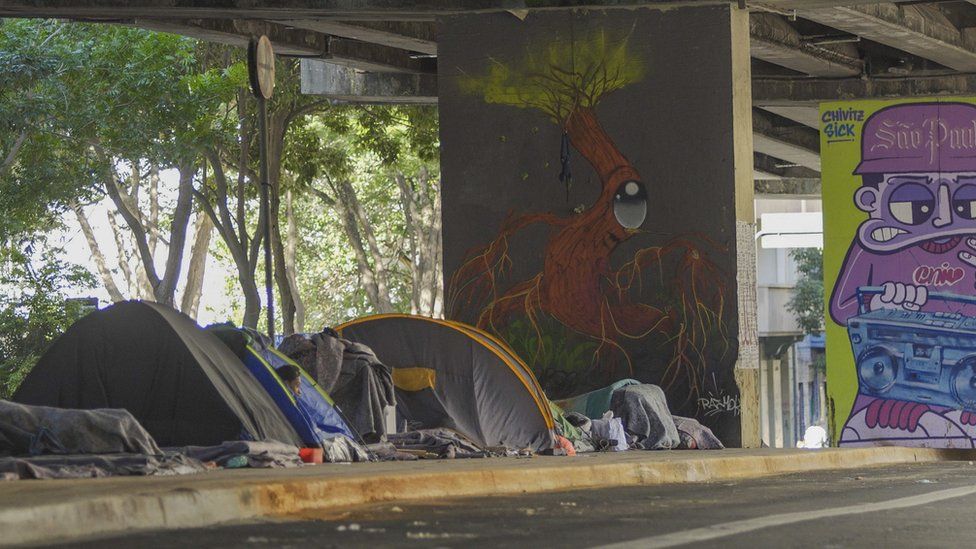The minhocão is one of São Paulo’s most famous landmarks. An elevated highway that snakes its way through the centre of the city, it weaves through the tightly packed apartment buildings to connect the east to the west.
The road’s official name is the Elevado Presidente João Goulart. But people here prefer to call it by its nickname, the minhocão, a reference to a giant mythical beast that roamed the forests of South America.
As much as it dominates the city with its sheer size, the minhocão also provides shelter for a growing number of people.
For underneath the elevated road, more and more homeless families are erecting tents, driven out of their homes by rising rent and having to sleep rough.
Many others have to make do with blankets handed to them by the city council.

And every day gets harder as the winter sets in.
São Paulo’s authorities estimate around 34,000 people are sleeping rough on the streets this year while figures from the Federal University of Minas Gerais put the number closer to 50,000.
The homeless population has soared more than 31% since the pandemic, and the number of families sleeping rough has risen 111% in the same time period, according to the city council.
With growing numbers of people needing help, the traditional strategies of soup kitchens and shelters are falling short.
So this year the city has come up with a new temporary solution: the micro-house.
The first village of micro-houses was built close to the banks of the Tiete River, in the neighbourhood of Canindé.

Home to one of São Paulo’s original favelas, today the site houses 20 or so families, each living in a little box that looks similar to a shipping container and measures 18 sq m.
A square with a playground gives the area a community feel. Children are playing with toys, their parents sitting on benches and watching on.
The aim is to build a total of 1,000 such villages across the city by the end of the year, housing 4,000 people.
“It’s a way of looking after people based on the well-known international concept of Housing First, offering housing as the first step in helping to get them back on their feet,” explains Carlos Bezerra Junior, who is the social welfare secretary at São Paulo City Hall, which is in charge of the project.
Daniela Martins, 30, walks me around her micro-house.

She shares a double bed with her husband Rafael, 32, and their four-year-old daughter Sofia. On the opposite wall, there’s a cot for three-month-old baby Henri.
The corner kitchen has a small stove, a sink and a fridge, and next to it is a simple bathroom.
The Covid-19 pandemic hit the family hard. Rafael lost his job as a sales assistant and Daniela’s work as a cleaner dried up.
They lived in a shelter for eight months before this opportunity came up.

“This is a place where we are trying to get back to living in society, to be human again, you know?” explains Rafael. “We just want a normal life – so many employers think that people who live in a shelter are bad people.”
The stigma that comes with losing a home makes getting back on your feet that much harder, say experts from homeless charities.
“Traditionally, those who are living on the streets are mostly male with some mental problems and issues with their families,” says Raquel Rolnik, professor at the Faculty of Architecture and Urban Planning of the University of São Paulo.

“Now we are talking about entire families living on the street. So clearly the issue is housing – the idea that the city administration is mobilising to address the topic of housing is good news.”
But, she says, the micro-houses are not a perfect solution.
“There is a lot of criticism about the format, the concentration of tiny homes grouped together in the same place, forming ghettos,” she explains.
She criticises the lack of urban planning and thinks better use could be made of existing, often abandoned, housing to make that habitable too.
Brazil is a country infamous for its inequality and immense favelas. But even these least desirable spaces – large areas of makeshift housing built by squatters – have become unaffordable for many.
“Of course it’s free for the first ones who squat, but not free for the second, for the third or for the 10th,” says Raquel Rolnik.
“They are also based on business activities – an activity of providing what is not provided in the formal market. And this in the context of a total absence of a housing policy.”

São Paulo’s largest favela is Paraisópolis (Paradise City in English), a name resident Eliane Carmo da Silva, who lives in a cramped room with mould growing on the walls, finds ironic.
Her home is in a little alleyway off the main road, on the ground floor, with at least two more floors of informally built flats above her.
Eliane and her husband pay $73 (£58) a month for a space large enough for a double bed, a cooker and a fridge but little more.
It is more than they can currently afford to pay. Their granddaughter, Rennylly Victoria, has a heart condition and the little they earn goes on the medication that keeps her alive.
While their landlord is understanding, it is getting harder to make ends meet, even though they receive food and aid from local charities.
“This month we had to use some rent money to buy her medicines,” Eliane explains, adding “I will never let her die.”
And she will not let her ambition die either. “At the moment, paying rent [means] we don’t make ends meet. Without donations, things would be incredibly difficult,” she says.
“My dream is to have my own house of course – work to earn money and keep pushing through.”
Related Topics
- Housing
- Sao Paulo
- Brazil
